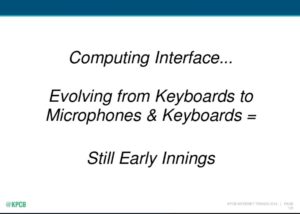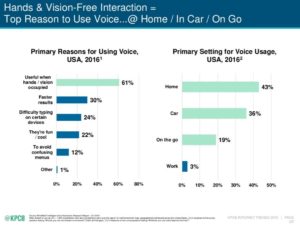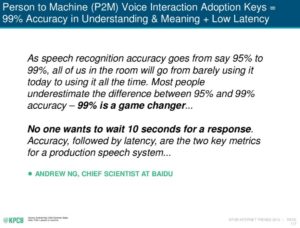I think I’m in love, and her name is Alexa.
Alexa is the voice of Amazon’s Echo. I purchased an Echo recently to start to understand how voice recognition and connected devices are going to change the way we live and work.
Make no mistake, this stuff will be transformative.
Voice search is here.

In her 2016 Internet Trends Report, Mary Meeker spends time looking at the rise of voice as a computing interface. She tracks the increase in voice searches over the past 18 months via Baidu, Android, Bing, and Siri. She says it’s all part of re-imagining human-computer interaction — and extends the concept of “always on” computing.
It’s not a work thing.

In a trends report filled with statistics, one of the facts that stands out in this section is that “work” is not a primary setting for voice usage. The workplace is going to catch up, but this isn’t a work-driven phenomenon. It’s a consumer, lifestyle one — which I believe is part of the reason for the speed at which we’re incorporating voice systems into our lives.
Call her Baby Alexa.

Right now voice recognition technology is mostly task-based. I can ask Alexa to find a playlist, look up a recipe, tune into a specific radio station, or even order a pizza or an Uber. I can set a timer (which is proving to be very useful). I can ask Alexa for the score of a baseball game or to look something up on Wikipedia.
But she’s far from perfect. When I asked for the score of a Wimbledon match, she didn’t understand. When I asked how tall Yankees pitcher Andrew Miller is, she couldn’t figure it out. She could tell me who Andrew Miller is, she could recite the basics of his Wikipedia entry — but the specific query I wanted answered she couldn’t process.
It’s baby steps.
As voice recognition improves, more and more products and services will have it baked in. You’ll also see more integration across platforms. (You can already see this in the pace that Amazon is adding services.)
As you play around with voice search on your phone, via your desktop, or with an Echo or similar device, think about what this means for you — and for the future of your organization and your industry.



